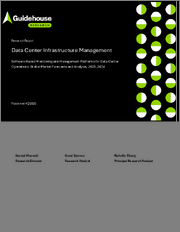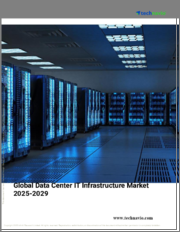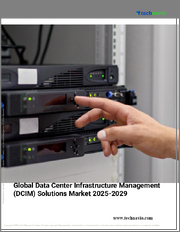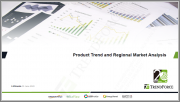
|
시장보고서
상품코드
1733103
세계의 데이터센터 인프라 관리 시장 조사 보고서 : 산업 분석, 규모, 점유율, 성장, 동향, 예측(2025-2033년)Global Data Center Infrastructure Management Market Research Report- Industry Analysis, Size, Share, Growth, Trends and Forecast 2025 to 2033 |
||||||
세계의 데이터센터 인프라 관리 시장 규모는 2024년 171억 6,000만 달러에서 2033년에는 738억 6,000만 달러로 성장하며, 2026-2033년의 예측 기간 중 17.61%의 견고한 연평균 성장률(CAGR)을 보일 것으로 예측됩니다.
데이터센터 인프라 관리(DCIM) 시장은 에너지 비용 상승과 효율성 향상에 대한 요구가 높아지면서 기업이 데이터센터 운영 최적화를 추구함에 따라 큰 폭의 성장이 예상되고 있습니다. 데이터센터가 복잡해짐에 따라 전력 사용량, 냉각 효율, 공간 활용을 가시화할 수 있는 통합 관리 솔루션에 대한 수요가 증가하고 있으며, DCIM 툴을 통해 기업은 인프라를 실시간으로 모니터링하고 관리할 수 있으며, 비용 절감과 운영 성능 향상을 위한 선제적 의사결정을 용이하게 합니다. 사전 예방적 의사결정을 쉽게 할 수 있습니다. 이러한 추세는 기업이 IT 전략을 지속가능성 목표와 일치시키기 위해 노력하는 가운데 특히 중요한 의미를 갖습니다.
또한 하이브리드 클라우드와 멀티 클라우드 환경의 부상으로 인해 고급 DCIM 솔루션의 필요성이 더욱 커지고 있습니다. 기업이 다양한 클라우드 전략을 채택함에 따라 여러 플랫폼에 걸친 리소스 관리의 복잡성이 증가하고 있으며, DCIM 소프트웨어는 전체 인프라에 대한 중앙 집중식 가시성을 제공함으로써 IT 팀이 리소스 할당을 최적화하고 워크로드를 효율적으로 분배할 수 있도록 지원합니다. 할 수 있습니다. 이 기능은 다운타임이 큰 재정적 영향을 미칠 수 있는 빠르게 진화하는 디지털 환경에서 성능과 안정성을 유지하는 데 필수적입니다.
또한 인공지능과 머신러닝을 DCIM 솔루션에 통합하는 것은 조직의 데이터센터 관리 방식에 혁명을 일으키고 있습니다. 이러한 기술은 잠재적인 문제가 발생하기 전에 예측 분석을 통해 잠재적인 문제를 예측하고, 사전 예방적 유지보수 및 리소스 최적화를 가능하게 하며, DCIM 시장이 계속 진화함에 따라 이러한 첨단 기술을 활용하는 조직은 운영 효율성 향상, 비용 절감 및 전반적인 서비스 제공 개선에 유리하게 작용할 것입니다. 개선할 수 있는 유리한 위치에 서게 될 것입니다.
당사의 보고서는 고객에게 다양한 산업 및 시장에 대한 종합적이고 실용적인 인사이트를 제공하기 위해 세심하게 작성되었습니다. 각 보고서는 시장 상황을 완전히 이해하기 위해 몇 가지 중요한 요소를 포함하고 있습니다.
시장 개요: 정의, 분류, 산업 현황 등 시장에 대한 자세한 소개.
시장 역학: 시장 성장에 영향을 미치는 주요 촉진요인, 억제요인, 기회 및 과제를 자세히 분석합니다. 이 섹션에서는 기술 발전, 규제 변화, 새로운 동향 등의 요인을 검토합니다.
세분화 분석 : 제품 유형, 애플리케이션, 최종사용자, 지역 등의 기준에 따라 시장을 명확한 부문으로 분류합니다. 이 분석을 통해 각 부문의 성과와 잠재력을 파악할 수 있습니다.
경쟁 환경: 시장 점유율, 제품 포트폴리오, 전략적 구상, 재무 실적 등 주요 시장 기업에 대한 종합적인 평가. 주요 기업이 채택하고 있는 경쟁 역학 및 주요 전략에 대한 인사이트을 제공합니다.
시장 예측 : 과거 데이터와 현재 시장 상황을 바탕으로 일정 기간 중 시장 규모와 성장 추세를 예측합니다. 여기에는 정량적 분석과 미래 시장 궤적을 보여주는 그래프 표시가 포함됩니다.
지역 분석 : 지역별 시장 성과를 평가하고 주요 시장 및 지역 동향을 파악할 수 있습니다. 지역 시장 역학 및 비즈니스 기회를 이해하는 데 도움이 됩니다.
새로운 동향과 기회 : 현재 시장 동향과 새로운 시장 동향, 기술 혁신, 잠재적 투자 대상 분야를 파악합니다. 미래 시장 개발 및 성장 전망에 대한 인사이트를 제공합니다.
목차
제1장 서문
제2장 개요
- 시장의 하이라이트
- 세계 시장 스냅숏
제3장 데이터센터 인프라 관리 산업 분석
- 서론 : 시장 역학
- 시장 성장 촉진요인
- 시장 성장 억제요인
- 기회
- 업계 동향
- Porter's Five Forces 분석
- 시장의 매력 분석
제4장 밸류체인 분석
- 밸류체인 분석
- 원재료 분석
- 원재료 리스트
- 원재료 제조업체 리스트
- 주요 원재료의 가격 동향
- 잠재적 바이어 리스트
- 마케팅 채널
- 다이렉트 마케팅
- 인다이렉트 마케팅
- 마케팅 채널 발전 동향
제5장 세계의 데이터센터 인프라 관리 시장 분석 : 컴포넌트별
- 컴포넌트별 개요
- 컴포넌트별 과거 및 예측 데이터 분석
- 솔루션
- 서비스
제6장 세계의 데이터센터 인프라 관리 시장 분석 : 기능별
- 기능별 개요
- 기능별 과거 및 예측 데이터 분석
- 퍼포먼스 최적화
- 구성
- 운영 감시
- 리포트 & 대시보드
- 기타
제7장 세계의 데이터센터 인프라 관리 시장의 분석 : Tier 표준별
- Tier별 개요
- Tier별 과거 및 예측 데이터 분석
- Tier 1
- Tier 2
- Tier 3
- Tier 4
제8장 세계의 데이터센터 인프라 관리 시장 분석 : 데이터센터 규모별
- 데이터센터 규모별 개요
- 데이터센터 규모별 과거 및 예측 데이터 분석
- 소규모 데이터센터
- 중규모 데이터센터
- 대규모 데이터센터
제9장 세계의 데이터센터 인프라 관리 시장 분석 : 배포 모델별
- 배포 모델별 개요
- 배포 모델별 과거 및 예측 데이터 분석
- 온프레미스
- 클라우드
제10장 세계의 데이터센터 인프라 관리 시장 분석 : 업계별
- 업계별 개요
- 업계별 과거 및 예측 데이터 분석
- 은행, 금융 서비스, 보험
- 정부·공공 부문
- 헬스케어와 생명과학
- IT 및 ITeS
- 제조업
- 통신 업계
- 교육
- 미디어 & 엔터테인먼트
- 소매·E-Commerce
- 기타
제11장 세계의 데이터센터 인프라 관리 시장 분석 : 지역별
- 지역별 전망
- 서론
- 북미의 판매 분석
- 개요, 실적과 예측
- 북미 : 부문별
- 북미 국가별
- 미국
- 캐나다
- 멕시코
- 유럽의 판매 분석
- 개요, 실적과 예측
- 유럽 부문별
- 유럽 국가별
- 영국
- 프랑스
- 독일
- 이탈리아
- 러시아
- 기타 유럽
- 아시아태평양의 판매 분석
- 개요, 실적과 예측
- 아시아태평양 부문별
- 아시아태평양 국가별
- 중국
- 인도
- 일본
- 한국
- 호주
- 동남아시아
- 기타 아시아태평양
- 라틴아메리카의 판매 분석
- 개요, 실적과 예측
- 라틴아메리카 부문별
- 라틴아메리카 국가별
- 브라질
- 아르헨티나
- 페루
- 칠레
- 기타 라틴아메리카
- 중동 및 아프리카의 판매 분석
- 개요, 실적과 예측
- 중동 및 아프리카 부문별
- 중동 및 아프리카 국가별 리스트
- 사우디아라비아
- 아랍에미리트
- 이스라엘
- 남아프리카공화국
- 기타 중동 및 아프리카
제12장 데이터센터 인프라 관리 기업의 경쟁 구도
- 데이터센터 인프라 관리 시장의 경쟁
- 파트너십/제휴/합의
- 합병·인수
- 신제품 발매
- 기타 개발
제13장 기업 개요
- 상위 기업의 시장 점유율 분석
- 시장 집중도
- ABB Ltd.
- Emerson Electric Co
- Commscope Inc.
- Eaton Corporation
- Vertiv Group Corp.
- Schneider Electric SE
- Johnson Controls International PLC
- IBM Corporation
- Huawei
- Cisco Systems Inc
Global Data Center Infrastructure Management Market size is anticipated to grow from USD 17.16 Billion in 2024 to USD 73.86 Billion by 2033, showcasing a robust Compound Annual Growth Rate (CAGR) of 17.61% during the forecast period of 2026 to 2033.
The data center infrastructure management (DCIM) market is set for substantial growth as organizations increasingly seek to optimize their data center operations amidst rising energy costs and the need for enhanced efficiency. As data centers become more complex, the demand for integrated management solutions that provide visibility into power usage, cooling efficiency, and space utilization is intensifying. DCIM tools enable organizations to monitor and manage their infrastructure in real-time, facilitating proactive decision-making that can lead to significant cost savings and improved operational performance. This trend is particularly relevant as businesses strive to align their IT strategies with sustainability goals.
Furthermore, the rise of hybrid and multi-cloud environments is driving the need for advanced DCIM solutions. As organizations adopt diverse cloud strategies, the complexity of managing resources across multiple platforms increases. DCIM software provides a centralized view of the entire infrastructure, allowing IT teams to optimize resource allocation and ensure that workloads are distributed efficiently. This capability is essential for maintaining performance and reliability in a rapidly evolving digital landscape, where downtime can have significant financial implications.
In addition, the integration of artificial intelligence and machine learning into DCIM solutions is revolutionizing how organizations manage their data centers. These technologies enable predictive analytics that can forecast potential issues before they arise, allowing for proactive maintenance and resource optimization. As the DCIM market continues to evolve, organizations that leverage these advanced technologies will be better positioned to enhance their operational efficiency, reduce costs, and improve overall service delivery.
Our reports are meticulously crafted to provide clients with comprehensive and actionable insights into various industries and markets. Each report encompasses several critical components to ensure a thorough understanding of the market landscape:
Market Overview: A detailed introduction to the market, including definitions, classifications, and an overview of the industry's current state.
Market Dynamics: In-depth analysis of key drivers, restraints, opportunities, and challenges influencing market growth. This section examines factors such as technological advancements, regulatory changes, and emerging trends.
Segmentation Analysis: Breakdown of the market into distinct segments based on criteria like product type, application, end-user, and geography. This analysis highlights the performance and potential of each segment.
Competitive Landscape: Comprehensive assessment of major market players, including their market share, product portfolio, strategic initiatives, and financial performance. This section provides insights into the competitive dynamics and key strategies adopted by leading companies.
Market Forecast: Projections of market size and growth trends over a specified period, based on historical data and current market conditions. This includes quantitative analyses and graphical representations to illustrate future market trajectories.
Regional Analysis: Evaluation of market performance across different geographical regions, identifying key markets and regional trends. This helps in understanding regional market dynamics and opportunities.
Emerging Trends and Opportunities: Identification of current and emerging market trends, technological innovations, and potential areas for investment. This section offers insights into future market developments and growth prospects.
SEGMENTATION COVERED IN THE REPORT
By Component
- Solution
- Service
By Functionality
- Performance optimization
- Configuration
- Operation Monitoring
- Reporting & Dashboards
- Others
By Tier Standards
- Tier 1
- Tier 2
- Tier 3
- Tier 4
By Data Centre Size
- Small Data Center
- Medium Data Center
- Large Data Center
By Deployment Model
- On-Premises
- Cloud
By Industry Vertical
- Banking, Financial Services and Insurance
- Government and Public Sector
- Healthcare and Life Sciences
- IT and ITeS
- Manufacturing
- Telecommunications
- Education
- Media & Entertainment
- Retail & Ecommerce
- Others
- COMPANIES PROFILED
- ABB Ltd.
- Emerson Electric Co
- Commscope Inc.
- Eaton Corporation
- Vertiv Group Corp.
- Schneider Electric SE
- Johnson Controls International PLC
- IBM Corporation
- Huawei
- Cisco Systems Inc.
- The above list can be customized.
TABLE OF CONTENTS
1. PREFACE
- 1.1. Report Description
- 1.1.1 Objective
- 1.1.2 Target Audience
- 1.1.3 Unique Selling Proposition (USP) & offerings
- 1.2. Research Scope
- 1.3. Research Methodology
- 1.3.1 Market Research Process
- 1.3.2 Market Research Methodology
2. EXECUTIVE SUMMARY
- 2.1. Highlights of Market
- 2.2. Global Market Snapshot
3. DATA CENTER INFRASTRUCTURE MANAGEMENT INDUSTRY ANALYSIS
- 3.1. Introduction - Market Dynamics
- 3.2. Market Drivers
- 3.3. Market Restraints
- 3.4. Opportunities
- 3.5. Industry Trends
- 3.6. Poerter's Five Force Analysis
- 3.7. Market Attractiveness Analysis
- 3.7.1 Market Attractiveness Analysis By Component
- 3.7.2 Market Attractiveness Analysis By Functionality
- 3.7.3 Market Attractiveness Analysis By Tier Standards
- 3.7.4 Market Attractiveness Analysis By Data Centre Size
- 3.7.5 Market Attractiveness Analysis By Deployment Model
- 3.7.6 Market Attractiveness Analysis By Industry Vertical
- 3.7.7 Market Attractiveness Analysis By Region
4. VALUE CHAIN ANALYSIS
- 4.1. Value Chain Analysis
- 4.2. Raw Material Analysis
- 4.2.1 List of Raw Materials
- 4.2.2 Raw Material Manufactures List
- 4.2.3 Price Trend of Key Raw Materials
- 4.3. List of Potential Buyers
- 4.4. Marketing Channel
- 4.4.1 Direct Marketing
- 4.4.2 Indirect Marketing
- 4.4.3 Marketing Channel Development Trend
5. GLOBAL DATA CENTER INFRASTRUCTURE MANAGEMENT MARKET ANALYSIS BY COMPONENT
- 5.1. Overview By Component
- 5.2. Historical and Forecast Data Analysis By Component
- 5.3. Solution Historic and Forecast Sales By Regions
- 5.4. Service Historic and Forecast Sales By Regions
6. GLOBAL DATA CENTER INFRASTRUCTURE MANAGEMENT MARKET ANALYSIS BY FUNCTIONALITY
- 6.1. Overview By Functionality
- 6.2. Historical and Forecast Data Analysis By Functionality
- 6.3. Performance optimization Historic and Forecast Sales By Regions
- 6.4. Configuration Historic and Forecast Sales By Regions
- 6.5. Operation Monitoring Historic and Forecast Sales By Regions
- 6.6. Reporting & Dashboards Historic and Forecast Sales By Regions
- 6.7. Others Historic and Forecast Sales By Regions
7. GLOBAL DATA CENTER INFRASTRUCTURE MANAGEMENT MARKET ANALYSIS BY TIER STANDARDS
- 7.1. Overview By Tier Standards
- 7.2. Historical and Forecast Data Analysis By Tier Standards
- 7.3. Tier 1 Historic and Forecast Sales By Regions
- 7.4. Tier 2 Historic and Forecast Sales By Regions
- 7.5. Tier 3 Historic and Forecast Sales By Regions
- 7.6. Tier 4 Historic and Forecast Sales By Regions
8. GLOBAL DATA CENTER INFRASTRUCTURE MANAGEMENT MARKET ANALYSIS BY DATA CENTRE SIZE
- 8.1. Overview By Data Centre Size
- 8.2. Historical and Forecast Data Analysis By Data Centre Size
- 8.3. Small Data Center Historic and Forecast Sales By Regions
- 8.4. Medium Data Center Historic and Forecast Sales By Regions
- 8.5. Large Data Center Historic and Forecast Sales By Regions
9. GLOBAL DATA CENTER INFRASTRUCTURE MANAGEMENT MARKET ANALYSIS BY DEPLOYMENT MODEL
- 9.1. Overview By Deployment Model
- 9.2. Historical and Forecast Data Analysis By Deployment Model
- 9.3. On-Premises Historic and Forecast Sales By Regions
- 9.4. Cloud Historic and Forecast Sales By Regions
10. GLOBAL DATA CENTER INFRASTRUCTURE MANAGEMENT MARKET ANALYSIS BY INDUSTRY VERTICAL
- 10.1. Overview By Industry Vertical
- 10.2. Historical and Forecast Data Analysis By Industry Vertical
- 10.3. Banking, Financial Services and Insurance Historic and Forecast Sales By Regions
- 10.4. Government and Public Sector Historic and Forecast Sales By Regions
- 10.5. Healthcare and Life Sciences Historic and Forecast Sales By Regions
- 10.6. IT and ITeS Historic and Forecast Sales By Regions
- 10.7. Manufacturing Historic and Forecast Sales By Regions
- 10.8. Telecommunications Historic and Forecast Sales By Regions
- 10.9. Education Historic and Forecast Sales By Regions
- 10.10. Media & Entertainment Historic and Forecast Sales By Regions
- 10.11. Retail & Ecommerce Historic and Forecast Sales By Regions
- 10.12. Others Historic and Forecast Sales By Regions
11. GLOBAL DATA CENTER INFRASTRUCTURE MANAGEMENT MARKET ANALYSIS BY GEOGRAPHY
- 11.1. Regional Outlook
- 11.2. Introduction
- 11.3. North America Sales Analysis
- 11.3.1 Overview, Historic and Forecast Data Sales Analysis
- 11.3.2 North America By Segment Sales Analysis
- 11.3.3 North America By Country Sales Analysis
- 11.3.4 United States Sales Analysis
- 11.3.5 Canada Sales Analysis
- 11.3.6 Mexico Sales Analysis
- 11.4. Europe Sales Analysis
- 11.4.1 Overview, Historic and Forecast Data Sales Analysis
- 11.4.2 Europe By Segment Sales Analysis
- 11.4.3 Europe By Country Sales Analysis
- 11.4.4 United Kingdom Sales Analysis
- 11.4.5 France Sales Analysis
- 11.4.6 Germany Sales Analysis
- 11.4.7 Italy Sales Analysis
- 11.4.8 Russia Sales Analysis
- 11.4.9 Rest Of Europe Sales Analysis
- 11.5. Asia Pacific Sales Analysis
- 11.5.1 Overview, Historic and Forecast Data Sales Analysis
- 11.5.2 Asia Pacific By Segment Sales Analysis
- 11.5.3 Asia Pacific By Country Sales Analysis
- 11.5.4 China Sales Analysis
- 11.5.5 India Sales Analysis
- 11.5.6 Japan Sales Analysis
- 11.5.7 South Korea Sales Analysis
- 11.5.8 Australia Sales Analysis
- 11.5.9 South East Asia Sales Analysis
- 11.5.10 Rest Of Asia Pacific Sales Analysis
- 11.6. Latin America Sales Analysis
- 11.6.1 Overview, Historic and Forecast Data Sales Analysis
- 11.6.2 Latin America By Segment Sales Analysis
- 11.6.3 Latin America By Country Sales Analysis
- 11.6.4 Brazil Sales Analysis
- 11.6.5 Argentina Sales Analysis
- 11.6.6 Peru Sales Analysis
- 11.6.7 Chile Sales Analysis
- 11.6.8 Rest of Latin America Sales Analysis
- 11.7. Middle East & Africa Sales Analysis
- 11.7.1 Overview, Historic and Forecast Data Sales Analysis
- 11.7.2 Middle East & Africa By Segment Sales Analysis
- 11.7.3 Middle East & Africa By Country Sales Analysis
- 11.7.4 Saudi Arabia Sales Analysis
- 11.7.5 UAE Sales Analysis
- 11.7.6 Israel Sales Analysis
- 11.7.7 South Africa Sales Analysis
- 11.7.8 Rest Of Middle East And Africa Sales Analysis
12. COMPETITIVE LANDSCAPE OF THE DATA CENTER INFRASTRUCTURE MANAGEMENT COMPANIES
- 12.1. Data Center Infrastructure Management Market Competition
- 12.2. Partnership/Collaboration/Agreement
- 12.3. Merger And Acquisitions
- 12.4. New Product Launch
- 12.5. Other Developments
13. COMPANY PROFILES OF DATA CENTER INFRASTRUCTURE MANAGEMENT INDUSTRY
- 13.1. Top Companies Market Share Analysis
- 13.2. Market Concentration Rate
- 13.3. ABB Ltd.
- 13.3.1 Company Overview
- 13.3.2 Company Revenue
- 13.3.3 Products
- 13.3.4 Recent Developments
- 13.4. Emerson Electric Co
- 13.4.1 Company Overview
- 13.4.2 Company Revenue
- 13.4.3 Products
- 13.4.4 Recent Developments
- 13.5. Commscope Inc.
- 13.5.1 Company Overview
- 13.5.2 Company Revenue
- 13.5.3 Products
- 13.5.4 Recent Developments
- 13.6. Eaton Corporation
- 13.6.1 Company Overview
- 13.6.2 Company Revenue
- 13.6.3 Products
- 13.6.4 Recent Developments
- 13.7. Vertiv Group Corp.
- 13.7.1 Company Overview
- 13.7.2 Company Revenue
- 13.7.3 Products
- 13.7.4 Recent Developments
- 13.8. Schneider Electric SE
- 13.8.1 Company Overview
- 13.8.2 Company Revenue
- 13.8.3 Products
- 13.8.4 Recent Developments
- 13.9. Johnson Controls International PLC
- 13.9.1 Company Overview
- 13.9.2 Company Revenue
- 13.9.3 Products
- 13.9.4 Recent Developments
- 13.10. IBM Corporation
- 13.10.1 Company Overview
- 13.10.2 Company Revenue
- 13.10.3 Products
- 13.10.4 Recent Developments
- 13.11. Huawei
- 13.11.1 Company Overview
- 13.11.2 Company Revenue
- 13.11.3 Products
- 13.11.4 Recent Developments
- 13.12. Cisco Systems Inc
- 13.12.1 Company Overview
- 13.12.2 Company Revenue
- 13.12.3 Products
- 13.12.4 Recent Developments



















